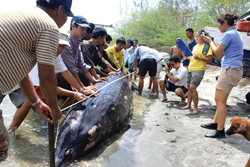OF THE
TIMES
What we suspect has really been happening, based on our research thus far, is that the upper atmosphere is cooling because it is being loaded with comet dust, which shows up in the form of noctilucent clouds and other upper atmospheric formations. The comet dust is electrically charged which is causing the earth's rotation to slow marginally. The slowing of the rotation is reducing the magnetic field, opening earth to more dangerous cosmic radiation and stimulating more volcanism. The volcanism under the sea is heating the sea water which is heating the lower atmosphere and loading it with moisture. The moisture hits the cooler upper atmosphere and contributes to a deadly mix that inevitably leads to an ice age, preceded for a short period by a rapid increase of greenhouse gases and "hot pockets" in the lower atmosphere, heavy rains, hail, snow, and floods.
Expect this trend to continue but don't believe in "man-made global warming". Whatever warming there has been, it's really a prelude to the way ice ages begin. Let's hope that there aren't any catastrophically large chunks in that stream of comet dust cycling through our solar system.

Comment: The wonder of computer models is that you can make them predict whatever you want to believe! It's interesting that the "ash cloud" that was shown to have spread over the northern hemisphere was not an actual observation but a prediction based on what their computer models were showing them! That's science in the 21st century for you folks - create your own reality, then measure it and you can "prove" that it's real!